This year I’ve been spacing out work on the survey, in the hope that it would be less exhausting, and I think it has worked! In this article I will combine all the worldwide data into one report.
The survey took place between 1st February and 25th March 2018, and there were 11,278 respondents, of which 1,535 said they were living in the UK.
The spreadsheets are split this year. Links: questions one, two, three, four, and the original spreadsheet of all responses.
Q1: The spelling of nonbinary
The first question in the survey was: How do you think this word should be spelled? The options were:
- nonbinary
- non-binary
- non binary
- I don’t know/I don’t care
- Other [text box]
The first three options, bolded, were randomised. I asked this question first because there was also a question about how people identify, and I had to choose a spelling for the checkbox option for nonbinary, and I didn’t want my choice for the survey to sway the results of this question. I also avoided using the word nonbinary in all promotional materials.
You can see and download the Google Sheet of the results here and you can see a more in-depth report here.
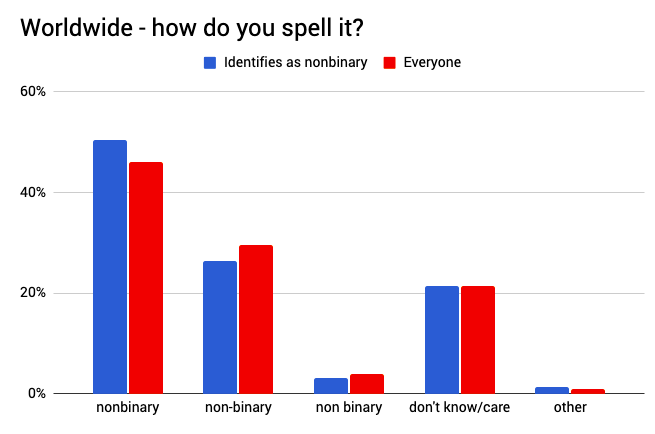
That’s:
- nonbinary – 50.3%
- non-binary – 26.3%
- non binary – 3.1%
- don’t know/care – 21.5%
- other – 1.3%
There’s one interesting thing to note here. When I limited the chart to only UK respondents, “non-binary” with a hyphen was more popular by a long way. I feel it’s pretty safe to put this down to British vs. American spelling conventions, since Brits do favour pointless hyphens (speaking as a Brit)!
Q2. Identity words
I asked, Which of the following best describe(s) in English how you think of yourself?
There were 23 checkbox options, and participants could check as many boxes as they wanted. You can see the spreadsheet of all 11,000+ responses for this question, as well as the graphs in more detail, here on Google Sheets and you can see the report about identity words only here.
The top five were:
- nonbinary – 60.6% (down 5.2%)
- trans – 34.8% (up 4.7%)
- genderqueer – 30.8% (down 3.5%)
- transgender – 27.9% (up 4%)
- agender – 26.1% (down 7%)
“Transgender” dropped out of the top 5 last year, and this year it’s back – it’s been hovering between 24% and 31% since the survey began in 2013. “Genderqueer” continues its steep decline in use, and I note that “fluid gender/genderfluid” seems to be on a more shallow but steady decline too. “Enby” continues to gain popularity – it’s now at around 25%.
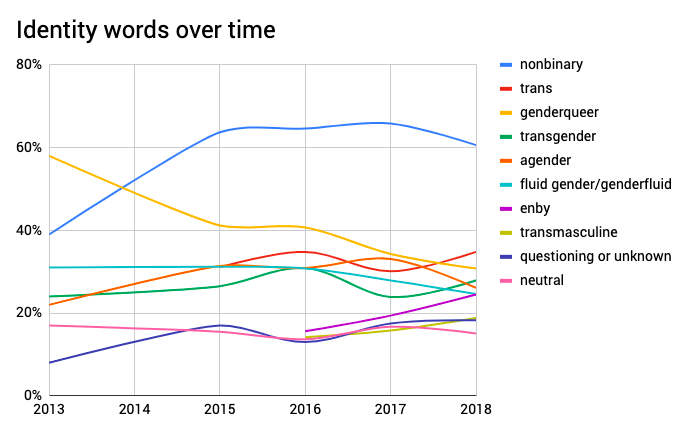
This is the first year that “nonbinary” has taken a definite dip, which I think is probably because of my efforts to reduce bias by removing the words “nonbinary” and “genderqueer” from all of the promotional posts online. I’m hoping this is a good sign and the start of a more representative set of results!
Here’s a graph of all the identity words that were chosen or entered by over 1% of participants:
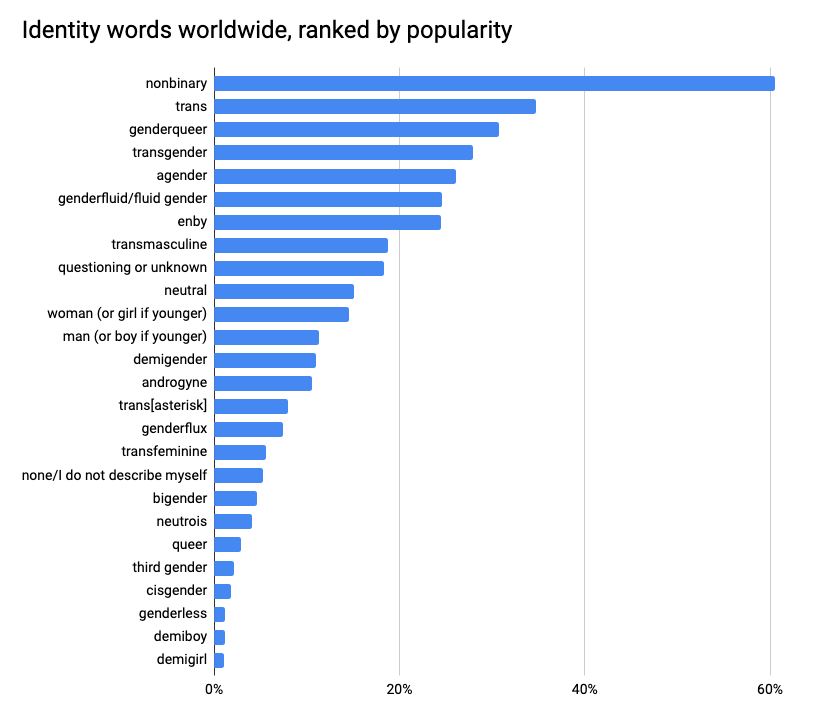
You can see a larger version of this chart by clicking through to the Google Sheet linked above.
In all there were 1,885 unique write-ins, of which four were words that were entered by over 1% of participants, which means next year the following words will be added to the survey’s checkbox options:
- queer – 2.9%
- genderless – 1.1%
- demiboy – 1.1%
- demigirl – 1.1%
- gender non-conforming – 1.1%
People seem to want to specify demiboy or demigirl even when demigender is an option, so I think it might be wise to remove demigender from the list and see what happens. It might be that over 1% of participants will write in demigender, in which case I will re-add it to the checkbox list.
Gender non-conforming was a tricky one to count. I had sorted the list of write-ins alphabetically and I noticed that it was being entered many times but being spelled in a lot of different ways, and therefore wasn’t being counted properly. When I searched the list for “conform” I found 23 unique spellings, 15 of which had been entered only once. When they were combined there were 122 participants entering some variation, with “gender non-conforming” being the most popular, so I will be adding that to the next survey.
Fun facts:
- 78% of write-ins were entered only once, and 429 words were written in more than once.
- 37% of participants used the write-in box.
- When the write-in boxes were used, on average people wrote in 1.4 new terms each.
- 93 people, or 0.8%, used all five boxes.
- The mean number of identity words (including the checkboxes) was 4.1 each, and the most common number of identity words chosen/written was 3.
- 90% of people chose 1-7 words.
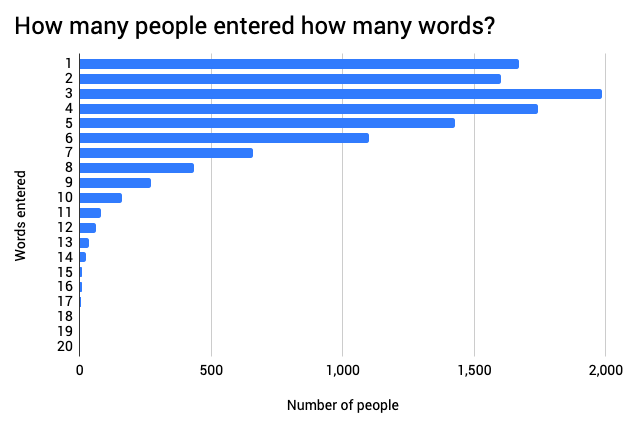
Q3. The title question
I asked, Supposing all title fields on forms were optional and write-your-own, what would you want yours to be in English? I also clarified that participants should be currently entitled to use it, so they should have a doctorate if they choose Dr, etc.
There were 5 specific titles to choose from, plus a few options like “I choose on the day” and “a non-gendered professional or academic title”. Participants could choose only one, with the goal of finding out what, when pressed, people enter on official records forms and ID. You can see the spreadsheet of all 11,000+ responses for this question, as well as the graphs in more detail, here on Google Sheets.
The top 5 were:
- Mx – 32.6% (up 3.0%)
- No title at all – 32.4% (up 1.6%)
- Mr – 8.5% (up 3.5%)
- Ms – 5.7% (up 2.9%)
- Non-gendered prof/acad. – 5.4% (down 10.6%)
I think it’s interesting to note that Mx, no title, Mr and Ms went up by 11% between them – very close to the 10.6% dip for non-gendered professional/academic titles. Perhaps the revised wording for this question, specifying that participants should have earned or been born with their titles, helped to get more accurate responses here.
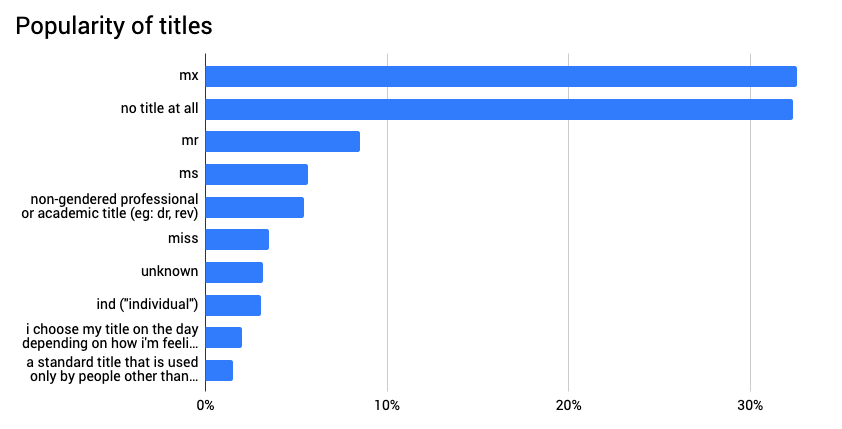
Mx and “no title” swapped places again this year, as they have done since the start of the survey, but they seem to be getting closer over time – this year, in over 11,000 participants, the difference between the two was only 25 people, or 0.2%. As always, they are far ahead of any other title, with the next two being Mr and Ms – both under 10% each.

“Professional/academic title” took a big dip, down 10%. I think this might be because the question now specifies that you should be currently entitled to use it. On the assumption that the lack of clarity in previous years means that the data is misleading, I have removed data from previous years for that title.
Of the 171 people (1.5%) who said that in an ideal world they prefer a gender-exclusive title, only 29 used the text box to specify what that title is. A lot of those text box entries were discussions of titles as a concept or varying preferences, but here are the top 5 specified gender-exclusive nonbinary titles:
- Mx – 3
- M – 3
- Mv – 2
- Mn – 2
- Comrade – 2
So I’d say that we do not currently have a gender-exclusive nonbinary title yet…!
(By “gender-exclusive nonbinary title”, I mean a title that denotes a nonbinary gender, as generally speaking Ms denotes a female gender and Mr denotes a male gender.)
Q4. The pronoun question
The fourth question was actually a complex set of questions, which started with Supposing all pronouns were accepted by everyone without question and were easy to learn, which pronouns are you happy for people to use for you? This was accompanied by a list of pre-written checkbox options. It included “a pronoun set not listed here”. and if you chose that it took you to a separate set of questions that let you enter up to five pronoun sets in detail.
You can see the spreadsheet of results for just the pronouns question here, and a more detailed report here.
Everything that was a pre-written checkbox option got over 1%.
Here’s the top 5:
- Singular they – they/them/their/theirs/themself – 77.4% (down 3.1%)
- He – he/him/his/his/himself – 31.2% (up 3.3%)
- She – she/her/her/hers/herself – 30.9% (up 1.7%)
- Mix it up – 13.8% (up 0.2%)
- None/avoid pronouns – 10.1% (down 0.6%)
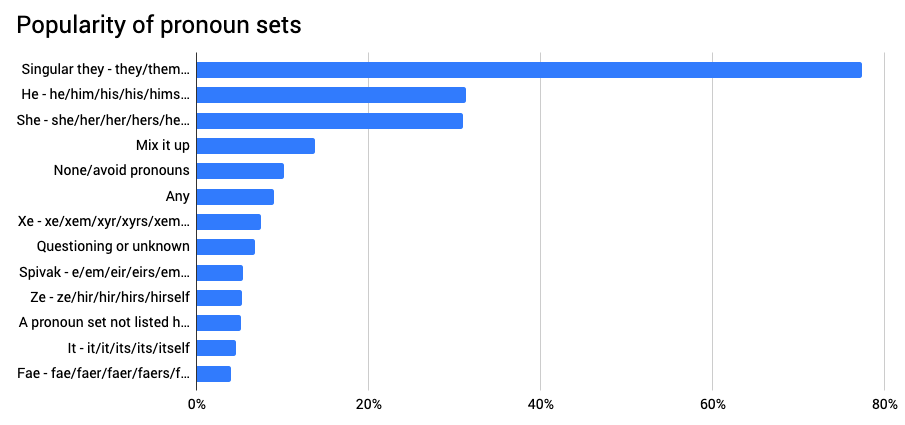
And here’s how it looks as a chart over time:
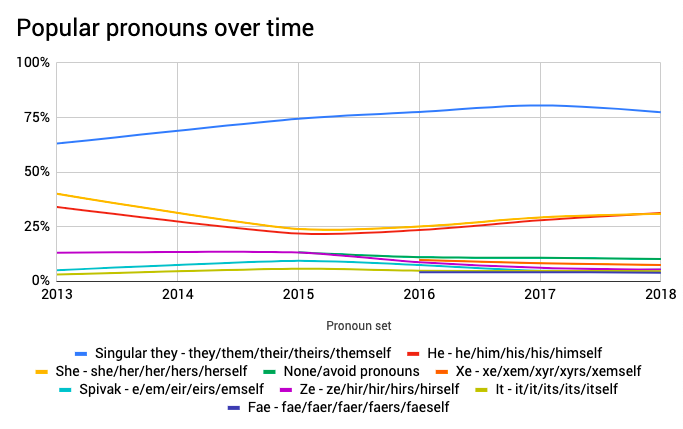
The top 5 pronouns remain the same as the last two years, but this is the first year on record (admittedly records don’t go very far back) where he/him was more popular than she/her. As usual, he/him and she/her are each less than half as popular as they/them. 1,036 people (~9%) weren’t happy with they/them, he/him or she/her for themselves, and about 7% entered no pronouns at all.
Neopronouns
Even when you only count the first form of each neopronoun set (xe, or ae, or ne), the most any neopronoun set got was 0.5%. (I am discounting they/them, which scored very highly in the neopronouns section, presumably because people didn’t spot it in the checklist in the previous question.)
Here’s the top 5:
- ze (singular verbs) – 0.49% (55 people)
- ve (singular verbs) – 0.45%
- ey (singular verbs) – 0.35%
- ne (singular verbs) – 0.35%
- ae (singular verbs) – 0.3%
In the end, the most popular neopronoun sets were in the checklist options, which makes sense – being able to check a box is much easier than having to enter five forms for each neopronoun set that you’re happy for people to use for you, as is remembering sets that you’re happy for people to use when talking about you. The popular neopronouns from the checklist options were:
- Xe – xe/xem/xyr/xyrs/xemself – 7.4% (837 people)
- Spivak – e/em/eir/eirs/emself – 5.3%
- Ze – ze/hir/hir/hirs/hirself – 5.3%
- Fae – fae/faer/faer/faers/faeself – 3.9%
Xe/xem has been declining in use since it was added to the checklist options in 2016, and the Spivak set has been hovering between 5% and 9% for several years now.
I am extremely happy with the improvements to this question. It’s great to get more complete information about neopronoun sets, and to be able to say with certainty exactly how each neopronoun set is most commonly composed. Next year I would like to expand this question to collect data about how people tend to gender their neopronoun sets, as I did a few months back when I ran the pronoun-specific survey that helped inform this question.
If you’re not super familiar with neopronouns, you can see the more popular ones from these results in use here.
Here’s some fun statistics:
- 63 unique pronouns were typed into the “other” box more than once.
- 314 pronouns were typed into the “other” box only once. This is much higher than last year because we’re collecting more accurate information about variants now.
- Including the checkbox options that’s 385 pronoun sets in total.
- People chose on average 2 acceptable pronouns each, the same as the last two years.
- Most people (41%) chose only one pronoun, slightly less than last year.
- About 75% of people were happy with only one or two pronouns – higher than last year.
The questions I ask
- What should the third gender option on forms be called? – Still no consensus in that area. Nonbinary is consistently popular, is at 60% this year, and is twice as popular as the next specific word (genderqueer), so it’s promising. But there’s still 2 in 5 respondents not identifying as nonbinary, so I don’t feel comfortable jumping to that conclusion just yet.
- Is there a standard neutral title yet? – Not yet. Mx is still consistently far more popular than all other titles, but just as many nonbinary people want no title at all. It’s really important that activists campaigning for greater acceptance of gender diversity remember to fight for titles to be optional, too.
- Is there a pronoun that every nonbinary person is happy with? – No. The closest we have to a standard is singular they, and it’s important for journalists and anyone else with a style guide to allow it. But around a quarter of us are not happy with singular they, and 9% of us don’t like he, she or they pronouns.
- Are any of the neopronouns gaining ground in a way that competes with singular they? – No. This year the closest is “Xe – xe/xem/xyr/xyrs/xemself” (7.4% compared to singular they’s 77%). Users of these neopronouns will probably not reach consensus for many years – language and especially pronouns can be very slow to settle and gain ground. Even if one neopronoun does become very commonly used, many will continue to use other neopronouns for a long time to come.
This year in review
The survey hasn’t changed much, but the way I approach working on it has.
- Being disabled and moving house meant my energy levels were pretty unreliable. I took a bit-by-bit approach, processing the results for one question at a time and then writing up a report, before compiling everything into one large report. That’s why each question has its own Google Sheet! (Questions one, two, three, four, and the original spreadsheet of responses.)
And the number of people involved in the survey has increased such that I’ve needed to start paying for more stuff.
- I crowdfunded for the survey fees again, but I included fees for the domain name and the email server so I can use proper mailing list, because Gmail wouldn’t let me email everyone about the results last year. There are just too many of you.
What I’ll do differently next year
- I will make the wording in the promotional materials more inclusive. This year I made an image for the tweets and blog posts that had the words “male” and “female” on and there was some confusion over whether I meant gender or sex. (I meant both.) Next year I will refrain from using these words, and possibly use a non-text way to convey what I mean, so that potential participants aren’t put off by language that they feel excludes them.
- I’m actually pretty happy with how I handled most of it. I think the software is probably the best I’m going to find, the site and domain and mailing list set-up is a big improvement, the wording of the questions and the answer responses seem to be working.
Closing thoughts
I continue to be a little overwhelmed when the responses start rolling in at hundreds per hour. I love mashing the numbers about and getting something informative and interesting out of them, and I really hope other people enjoy reading the results! You’re all fab for trusting me with your answers too. Thank you.
Support me!
I do this basically for free (the crowdfunded money went entirely on survey software and domain fees), so if you happened to stumble onto my Amazon wishlist and accidentally fall on an Add To Cart button… well, I would be immensely grateful. 😉 If you wanted to go and check out Starfriends.org too I reckon Andréa would be pretty chuffed!
2018-10-15
email: hello@gendercensus.com